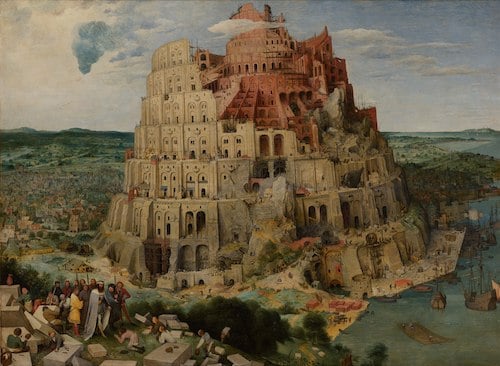The Tower of Babel in the Bible
After the Great Flood, man had again begun to multiply and fill the earth. They all spoke one language and understood one another well. They decided to build a tower which was to reach to heaven, to make them equal to G‑d, and at the same time, to make it possible for them to stay together. This symbol of their divine strength, as they thought, was to be built in the valley of the Land of Shinear.
G‑d decided to destroy their arrogance by destroying their ability to understand one another. He, therefore, confused the people by splitting them up into seventy different nations and tribes, each with a language of its own, (hence the name Babel, meaning “confusion”).
When this happened, the project of the Tower had to be given up. The various groups migrated in different directions and settled in all parts of the world.
The Tower of Babel Explained
There are a number of fascinating explanations on the subject to be found in the classic commentaries. Let's begin with the Talmud (Sandhedrin 109a) where we find three traditions:
In the School of Rabbi Shila it was taught that they built the tower with the intention of piercing the heavens with axes to drain all the water held therein, making it impossible for G‑d to bring another flood, should they vex Him again. (Perhaps what's meant by this is that they had embraced their understanding of science and its workings to the extent that they felt they were now able to spar with G‑d on His turf—the heavens.)
Rabbi Yirmiya bar Elazar taught that there were actually three groups; each with its own plans for the tower: One group planned to climb the tower, safely out of harm's way, should another flood come. A second camp wanted to use it as a shrine for idol worship. Yet a third group actually wanted to use it as a platform from which to battle G‑d.
Rabbi Natan, on the other hand, taught that all of them intended to serve idols.
The Targum Yerushalmi explains that the tower was to be crowned by the form of a man holding a sword in his hand—an act of defiance against the G‑d whom they hoped to overcome.
An interesting teaching in the Midrash is that they were afraid that the heavens would collapse regularly every 1656 years like it did during the flood, which took place in the year 1656 from Creation, and they therefore decided to build a scaffolding to support it.
The Maharal (Rabbi Yehuda Lowe, 16th century rabbi of Prague) explains the Midrash and the teachings of the School of Rabbi Shila to mean that they saw the Flood as a natural occurrence that took place as a result of the movements of the celestial spheres and their positioning in the sky at the time of the Flood. The purpose of the tower was to somehow change what they perceived as the natural weather pattern.
Rabbi Obadiah Sforno (15th-16th Century) explains that their plan to place an idol on top of the tower was so that it would gain universal acclaim as the world's tallest shrine and greatest god, making it the center of worship for all—with the result that the one who ruled that city would rule all humankind.
Rabbeinu Bachya (13th-14th Century) gives a number of explanations. On an elementary level, he explains that their plan was to build a monument that would be seen from many miles around. They wanted to settle together, and decided that they would all remain within view of the tower and never stray from it. Anyone who strayed too far from the metropolis would have the tower to guide him back. This, however, was not G‑d's plan, since He created us to settle the world—all of it—and make it a better place.
He also suggests that they may have actually been creating the first lightning rod. They knew that G‑d had promised not to bring another flood, and feared that He would instead punish those who rebel with fire. They hoped that the tower would serve to divert any electrical storms that G‑d would send their way. (Note that Bachya lived many centuries before Franklin.)
The Netziv (Rabbi Naphtali Tzvi Yehuda Berlin, the19th century Rosh Yeshiva of the famed Volozhin Yeshiva) has a fascinating and very instructive view on their plan. He explains that they were the first social engineers—hoping to create a utopian society where all lived and thought as one. They feared that if some people would settle their own colonies and towns, they would develop their own cultures and unique modes of living. They wanted everyone to live in one controlled environment where they would be able to make sure that all remain culturally homogenous. The tower served as a base around which all people of their planned colony would settle—no one leaving its immediate environs. The problem with their plan was that it was the first step toward a tyrannical state where no individual expression would be tolerated, and G‑d split them into separate nations.
The Lubavitcher Rebbe once explained the episode as follows: They planned a tower which would be a monument to inspire commitment to their common goal—survival. They wanted to ""make for ourselves a name""—to ensure the continuity of the human race.
Where did they go wrong?
Precisely that was their error: they saw survival as an end in itself. Let us make a name for ourselves, they said; let us ensure that there will be future generations who will read of us in their history books. To them, life itself was an ideal, survival itself a virtue.
This was the beginning of the end. Nature abhors a vacuum, and this is true of spiritual realities as well: unless a soul or cause is filled with positive content, corruption will ultimately seep in. A hollow name and shrine soon becomes a tower of Babel.











Join the Discussion